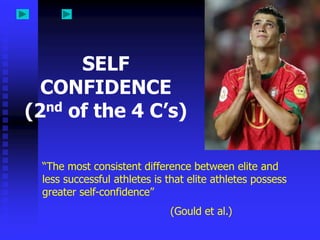
Self confidence
- 1. SELF CONFIDENCE (2 nd of the 4 C’s) “The most consistent difference between elite and less successful athletes is that elite athletes possess greater self-confidence” (Gould et al.)
- 2. Self Efficacy • Bandura put forward the notion that as people become competent in particular skills and situations they develop a feeling of self efficacy. • Self efficacy is self confidence in a specific situation. Expectations of self efficacy can effect the choice of activity, the amount of effort expended and persistence at the task. • Self efficacy is different from self confidence. Someone may be generally self confident in sport but when it came to playing golf which they weren‟t particularly good at, they may have low self efficacy in that situation.
- 3. Bandura proposed that people with high self efficacy a) Seek challenges, apply effort and persevere (TAS) b) Attribute success to effort and ability (internally) • People who expect to be confident in a particular situation are more likely to choose that activity. • Our expectations of whether or not self confidence is going to be high or low may determine the activity we choose, the amount of effort we put into it and whether we stick with the task or give up easily.
- 4. • Write down 5 situations in sport where you feel a low sense of self efficacy. How do you account for these feelings of low self confidence? Some examples In football, a midfielder having to play in goal. A male having to play in a netball game.
- 5. Factors Affecting Self Efficacy • Our expectations of self efficacy depend on 4 types of information 1. Performance accomplishments – These probably have the strongest influence on self confidence. If success has been experienced in the past, then feelings of self confidence are likely to be high
- 6. 2. Vicarious experiences – This refers to what we have observed before. If we watch others perform and be successful, then we are more likely to experience high self efficacy. 3. Verbal persuasion – If we are encouraged to try a particular activity, our confidence in that situation may increase. 4. Emotional arousal – Our perceptions of how aroused we are can effect our confidence in a particular situation.
- 7. Performance accomplishments Vicarious experiences Efficacy Expectations Behaviour patterns Choice Goals Performance Effort Worry Persistence Attributions Verbal persuasion Emotional arousal
- 8. • You would like a fellow student to attempt a high jump but he has low self confidence. Using Bandera‟s four factors which influence self-efficacy, state how you would try and raise the athlete‟s self efficacy in this situation.
- 9. 1. Try to give him initial success by lowering the bar to start with or using some flexi rope 2. Demonstrate how it can be done, or if you are much better than him, use someone of a similar ability 3. Verbally encourage the athlete. Tell him that he should „have a go‟. 4. Tell him that to be worried is a natural, very positive response because it prepares the body well
- 10. Vealey’s Sport Specific Model of Sport Confidence • Vealey defines sport confidence as “the belief or degree of certainty individuals possess about their ability to be successful in sport”.
- 11. Sports Specific Model of Sports Confidence 1 Trait sport 1 confidence (SC- 1 The Sport Competitive trait) Situation Orientation 2 State sport confidence (SC- state) 3 5 Positive results Performance in the sport Positive results cause increase trait situation (behavioural the type of goal to be confidence responses) changed for the next 6 performance 4 a)Results of Performance b) Subjective Outcomes c)Perceived Success d)Perceived attributions e)Performance satisfactions
- 12. Practical Example of Vealey‟s Sport Specific model of Sports Confidence. 1. The sports situation is a cricketer going into bat with the score at 250 for 1 (very good situation). SC-trait = High confidence due to a high score in the previous game. Competitive orientation = The batsman has an outcome goal of scoring 40 runs. If he gets any less than that he would consider it a failure.
- 13. 2. The combination of the previous factors (1) would determine the SC-state, which in this case would be very high. 3. The combination of 1 and 2 would determine how well the cricketer will perform. In this case the chances are that he will perform quite well considering the previous factors.
- 14. 4. Depending on how well the cricketer performed (3) the following factors will be evaluated after the match. a) Results of performance (was he successful or not according to his goal) b) Subjective outcome (How did other people rate the performance) c) Perceived Success (whether the goal was met or not, did he feel like he succeeded?) d) Perceived Attribution (Why did he perform well / badly. Was it internal / external reasons e) Performance satisfaction (Was he happy with the performance)
- 15. 5. If the outcomes of 3 and 4 were positive then this will lead to an increase in trait confidence. 6. If the goals that were set in 1 were met, the cricketer will change the goal next time around. The cricketers last outcome goal was to score 40 runs. If he scored 80 in the previous innings then this goal would be increased to say 50 or 60. If he failed to meet his 40 run target then this would stay the same for the next innings.
